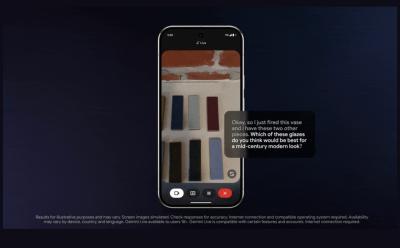At MWC 2025, Google showcased Project Astra within Gemini, signaling a bold step toward bringing real-time visual collaboration to Android users. The company announced that the much-anticipated AI feature would be available by the end of March, marking a tangible rollout plan after earlier demonstrations. A growing thread of user reports and firsthand testing has begun to corroborate the arrival, with early adopters noting that Astra is already live on certain devices. The core capability of Project Astra is to share your screen or camera so Gemini can see what you see and engage in voice chat in real time, creating a more interactive and responsive AI-assisted experience. In the official demonstrations, Gemini appears to be able to view the phone’s screen and hold a real-time conversation with the user, essentially turning the device into a collaborative workspace powered by AI. The feature can also leverage Gemini Live to share your surroundings through the camera, enabling instant interactions with the AI as you navigate your environment. Google has confirmed that the rollout is underway, though access remains gated by platform and subscription constraints. Astra integrates directly into the Gemini app and, as implemented so far, is available to Google One AI Premium subscribers, a plan priced at $19.99 per month. At present, the rollout is limited to Android devices, with no stated support for iOS in the immediate future. The ongoing rollout has sparked discussion about how AI-assisted visualization could transform daily tasks, study sessions, travel, and complex problem-solving that benefits from on-screen data.
Overview of Project Astra in Gemini
Project Astra represents Google’s strategic push to embed live, AI-assisted perception into mobile workflows. When activated, Astra enables a two-way interaction between the world on your screen and the Gemini AI assistant. The primary mechanism is screen-sharing, which allows Gemini to parse the contents of your display in real time. This capability means that Gemini can interpret charts, documents, web pages, and app interfaces as you navigate them, offering context-aware guidance and natural-language responses anchored in what you’re viewing. In practical terms, users can ask Gemini to summarize a chart, extract key figures from a spreadsheet, or explain steps shown on a tutorial video while the information remains onscreen. A complementary capability, Gemini Live, leverages the device’s camera to capture your surroundings and feed that visual input into the AI. This enables interactive conversations that reference physical context—like pointing the camera at a whiteboard, a product prototype, or a classroom setup—and receiving immediate, relevant feedback. The dual approach of Astra—screen visibility and live camera insight—expands the AI’s ability to comprehend not just digital content but physical environments as well.
Project Astra’s integration within Gemini signals Google’s intent to blur the lines between AI assistant tasks and real-world, hands-on activities. By enabling real-time vision and dialogue, Astra aims to support learning, exploration, and productivity in ways that were previously possible only with specialized software or higher-end hardware configurations. The feature’s emphasis on immediacy—seeing the user’s screen and surroundings and responding in real time—positions Astra as a tool for rapid problem-solving, guided study, or collaborative work where an AI partner can annotate, interpret, and explain on the fly. The broader implication is a mobile AI ecosystem in which the device becomes a dynamic interface for both digital content and physical contexts, with the Gemini assistant acting as a proactive co-pilot. This approach aligns with Google’s broader push toward AI-enhanced mobility, where user interactions are augmented by intelligent, context-aware feedback that adapts to what the user is doing at that moment. Astra’s design philosophy centers on reducing the friction between discovery, understanding, and action, enabling users to interact with complex information without switching apps or manually relaying data to the AI. The capability is poised to influence a wide range of activities, from education and research to remote assistance and travel planning, by making AI assistance more tangible and directly tied to the user’s immediate environment.
How Astra Works: Screen Sharing, Live Camera, and Real-Time Interaction
Astra’s operational model hinges on two core streams of input: the device screen and the camera. When the user activates screen sharing, Gemini gains a live view of the current display, allowing the AI to parse text, graphs, images, and UI elements as they appear. This enables a level of contextual understanding that goes beyond static prompts. The AI can reference exact on-screen content in its explanations, highlight terms, extract data, or guide the user through sequential steps with precision derived from what is visible at that moment. The result is a synchronized dance between what the user sees and what Gemini can infer and respond to in real time. The ability to anchor AI assistance to on-screen content promises to reduce confusion and accelerate problem-solving, especially in complex tasks that require attention to evolving data or multi-step workflows.
When Astra leverages Gemini Live with the camera, the user can expose their physical environment to the AI. This vision-based capability opens up new avenues for collaborative tasks: the AI can recognize objects, assess surroundings for safety or feasibility, and participate in conversations that reference real-world contexts. For example, in a study session, a student can show a problem being worked on a whiteboard or a textbook page, and Gemini can offer explanations, summarize the material, or propose alternate methods. In a travel scenario, a user could point the camera at a map or itinerary and receive live, advice-driven prompts tailored to the highlighted regions or travel constraints. These capabilities are intended to supplement, rather than replace, the user’s ability to interpret information, by providing near-instantaneous insights that draw upon both digital content and physical surroundings.
The combined use of screen sharing and live camera requires careful attention to permissions and privacy. Access to screen content demands explicit consent from the user, and ongoing transparency about what data is captured, stored, and used for AI processing is essential. In typical implementation, the system would provide clear prompts to authorize sharing for a given session and display indicators that the AI is actively viewing either the screen or the camera. These indicators help users maintain situational awareness of when their data is in view of the AI. The user experience is designed to be fluid: enable Astra when you need AI-assisted analysis, then disable it when privacy or data sensitivity is a concern. The architecture would likely balance low-latency transmission with robust privacy safeguards, ensuring that sensitive content—such as financial information, personal identifiers, or confidential work material—receives the appropriate protections. In practice, Astra’s performance is expected to scale with device capability and network conditions, with smoother experiences on higher-end Android devices and robust encryption to safeguard the data in transit and at rest.
From a usability perspective, the Astra workflow would benefit from intuitive controls and fast toggles. A typical session might begin with a quick activation gesture or button press, followed by a real-time prompt from Gemini explaining what is being shared and what the AI will do next. The AI could offer to annotate the on-screen content, summarize captured data, or provide step-by-step guidance as the user navigates through apps or documents. The on-screen prompts and voice responses would be designed to minimize cognitive load, guiding users through tasks without overwhelming them with information. The live camera feature could be used to capture demonstrations, show tangible artifacts, or provide situational context, all while allowing Gemini to respond to questions or requests for clarification. To maximize usefulness, Astra would likely integrate with Gemini’s existing capabilities, such as memory, retrieval, and planning features, enabling the AI to reference previous interactions and tailor its responses to the user’s ongoing goals. For creators, educators, students, and professionals, Astra’s real-time AI perception offers a potential leap in how people study, learn, and collaborate, bridging the gap between digital instruction and real-world observation.
Rollout Status, Availability, and Platform Limitations
The rollout status of Project Astra has been described as underway, with Google indicating that the feature would reach Android users by the end of March. Early adopters have reported that Astra is already functional on specific devices, including certain Xiaomi smartphones, which provides anecdotal validation beyond official announcements. The integration has been confirmed within the Gemini app, and accessibility is tied to Google One AI Premium, a subscription tier that costs $19.99 per month. As of now, Astra is limited to Android devices, with no formal announcement of iOS compatibility or cross-platform support. This platform-specific introduction aligns with Google’s broader strategy of leveraging its own mobile ecosystem to deliver a tightly integrated AI experience, while potentially limiting early access to a subset of users who subscribe to its premium AI services.
In parallel, the competitive landscape features related screen-sharing and live-camera capabilities across other AI platforms. OpenAI has introduced screen-sharing and live camera features within ChatGPT, with an associated monthly cost of $20. This positions OpenAI as a direct competitor in terms of feature parity, albeit with a different pricing model and ecosystem. Microsoft Copilot offers similar live vision capabilities, and in the United States, some users have gained access to Copilot Vision on Android and iOS without any subscription, implying a degree of early beta testing or a freemium trajectory. This context underscores a broader industry trend toward real-time AI perception on mobile devices, where major players are racing to provide immediate, visually-grounded assistance to users across platforms. The fragmentation in availability—subscription-only access for Astra versus widely deployed features for competitors—highlights a strategic choice by Google to monetize advanced AI capabilities through a premium plan, while other providers may pursue broader access or mixed models to expand user adoption.
From a user experience perspective, the timing of Astra’s release matters for both adoption rates and practical utility. Google contemporaneously emphasizes that the feature’s value grows with depth of integration into the Gemini ecosystem and the breadth of use cases it can support. For students and professionals who frequently work with digital documents, analytics dashboards, or educational materials on their devices, Astra promises to reduce the need for constant switching between apps or duplicating information across channels. The potential upside is substantial: real-time interpretation of complex content, contextual guidance based on what is visible on screen, and the ability to corroborate AI insights by citing exact elements on the display. However, given the premium subscription requirement, there is a natural emphasis on a higher-value segment of users who rely on Gemini for advanced AI assistance and are prepared to invest in the broader AI-first mobile experience. The rollout’s pace and scope will likely influence user expectations, developer momentum, and the tempo of feature refinements as Google balances performance, privacy, and monetization.
Practical Use Cases: Studying, Workflows, and Travel
Astra’s real-time, perception-based capabilities open a wide array of practical use cases across study, work, and travel scenarios. For students, Astra can transform study sessions by enabling the AI to analyze lecture slides, annotate key terms, and extract actionable insights from dense reading passages displayed on the screen. The ability to reference the current page or diagram while conversing with Gemini can help learners understand complex concepts more rapidly. In a classroom or homework setting, a student could show worked examples on a digital board, and Gemini could explain each step aloud, pause at points of confusion, and offer alternative problem-solving approaches. The live camera feature could capture a whiteboard write-up or a physical worksheet, allowing Gemini to interpret manual calculations or handwriting and provide feedback in real time. The combination of screen content and live environment interpretation enhances the AI’s capacity to tailor explanations to the learner’s immediate context, potentially accelerating comprehension and retention.
In professional contexts, Astra can streamline workflows that involve heavy data interpretation or multi-step instructions. For example, a data analyst could share a dashboard on the screen while asking Gemini to summarize trends, flag anomalies, or suggest next steps based on live visuals. A software engineer could project a code editor or architecture diagrams and solicit stepwise debugging guidance or design advice directly from the AI. The ability to see the developer’s current code state on screen and hear contextual explanations from Gemini could reduce context-switching overhead and improve collaboration with AI colleagues. In client-facing scenarios, Astra may help professionals present data-driven narratives by having Gemini annotate charts, generate talking points, and offer clarifications on the fly during meetings or demonstrations.
For travelers, Astra’s live perception features are particularly compelling. A user navigating a city could show a map, transit route, or signage to Gemini and receive real-time guidance, language translation, or safety tips aligned with the physical context. The camera feed could validate surroundings, verify directions, or identify landmarks for more accurate navigation assistance. Travel tasks, such as packing optimization, itinerary adjustments, or on-the-ground research, could benefit from continuous AI feedback anchored in the user’s immediate environment. The ability to ground AI insights in actual screen content and visible surroundings reduces ambiguity and enhances the trustworthiness of the AI’s recommendations, which is especially valuable when navigating unfamiliar locales or time-sensitive tasks.
In educational and research settings, Astra could be used to augment experimentation and data interpretation. Scientists, engineers, and researchers often rely on real-time data visualization, measurement readings, and methodological steps that appear on screens or notebooks. Astra would enable Gemini to read measurement values, interpret graphs, and provide concise explanations or restatements of experimental procedures as the user progresses. Students could work through problem sets with Gemini providing validation checks and alternative methods, while researchers could leverage Astra to annotate figures and compare live results with literature references shown on the screen. The breadth of potential use cases reflects how integrated AI perception can become a natural extension of human cognition when paired with a capable mobile AI assistant.
Security, Privacy, and Controls
Introducing screen sharing and live camera input into AI interactions raises important security and privacy considerations. The core concern is ensuring that sensitive information—such as confidential documents, personal data, financial records, or proprietary content—receives robust protection and is only accessible to the AI as authorized by the user. To address these concerns, Astra would need to implement strict session-based permissions, with clear indicators that the AI is actively accessing screen content or camera input. Users should be able to review and revoke permissions at any time, and there should be a straightforward mechanism to disable Astra instantly if privacy is compromised or if a session is no longer necessary.
Data handling is another critical aspect. The AI’s perception inputs—screen data and camera imagery—may be transmitted to cloud services for processing, depending on how Gemini’s architecture is designed. Transparent data handling policies, including information about what data is stored, how long it is retained, and whether it is used for model improvement, are essential for user trust. End-to-end encryption, secure data transfer, and strict access controls should be standard features. Users would benefit from granular controls that allow them to specify which apps or content can be accessed by Astra, and to set privacy presets that suit different contexts—professional work, academic study, or personal use.
In addition to technical safeguards, user education remains important. Clear, accessible onboarding materials should explain how Astra works, what data is shared, and how to manage permissions. Visual cues during sessions—such as on-screen banners or status indicators—help users stay aware of when the AI is observing their screen or surroundings. Periodic prompts to review privacy settings can empower users to maintain control over their data as the feature evolves. From a policy perspective, Google would need to align Astra with general data protection regulations and best practices for AI-driven perception, ensuring that user consent, data minimization, and purpose limitation principles are upheld.
For organizations considering deploying Astra in professional environments, governance would be essential. IT administrators may want to define policy controls around which devices and accounts can access Astra, how data from screen sharing is stored or processed, and what logging exists for auditing purposes. Compliance with enterprise privacy standards would be a key factor in broader adoption, particularly in industries with sensitive information. A careful approach to security and privacy can help balance the benefits of real-time AI perception with the legitimate need to protect confidential or sensitive content.
Competitive Landscape, Market Implications, and Strategy
Project Astra enters a market where real-time AI vision features are increasingly common across major platforms. OpenAI’s ChatGPT has introduced screen-sharing and live camera functionality, which reflects a broader industry trend toward enhancing AI perception on mobile devices. The pricing structure of these competitive offerings varies, with some providers charging monthly fees and others experimenting with freemium or trial access. Microsoft Copilot’s approach includes free access for certain users in the United States, highlighting a distinct strategy that seeks wide-scale adoption through tiered accessibility. In this environment, Google’s Astra differentiates itself through a tight integration with the Gemini ecosystem and a focus on Android-first deployment. By bundling Astra with Google One AI Premium, Google creates a monetization path that rewards users who rely on Gemini for advanced AI capabilities, while also signaling a premium, enterprise-friendly tier for serious users.
From a strategic perspective, Astra’s platform-specific rollout can be viewed as a phased approach to market entry. By prioritizing Android devices and tying access to a premium subscription, Google leverages its existing mobile and cloud infrastructure to deliver a compelling, controlled experience. This approach can help maintain quality of service, ensure data handling standards, and facilitate iterative improvements based on real-world usage. However, the limitation to a single ecosystem could delay broader adoption, especially among users who operate across iOS devices or who prefer cost-conscious models. The competitive dynamic suggests a race to deliver the most natural, context-aware AI assistant capable of perceiving both digital content and physical surroundings. As devices become more powerful and network connectivity improves, real-time perception features like Astra could become a baseline expectation for next-generation AI assistants rather than a premium differentiator.
In terms of market implications, Astra’s success will hinge on user adoption, perceived usefulness, and trust in data handling practices. If the feature proves to meaningfully enhance study efficiency, work productivity, and travel planning, a broad user base could justify continued investment in refinement and related features. The ability to demonstrate measurable productivity gains and learning outcomes would be crucial in marketing Astra to prospective subscribers and enterprise customers. Google’s ongoing development of Astra could influence partners and developers to create integrated workflows that leverage real-time AI perception, driving a broader ecosystem of tools, templates, and services designed to complement AI-powered mobile usage. The long-term outlook will likely depend on how well Astra can scale across a diverse set of devices, how privacy and security concerns are addressed, and how effectively it can deliver tangible value in everyday tasks.
Future Prospects: Roadmap, Enhancements, and the Vision for AI-First Mobile Computing
Looking ahead, Astra could evolve in several directions that align with broader ambitions for AI-first mobile computing. First, deeper integration with Gemini’s memory and retrieval systems could enable even more sophisticated context retention, enabling the AI to recall prior screen interactions, correlate them with ongoing tasks, and proactively offer relevant insights. As the AI’s perception capabilities mature, it could begin to anticipate user needs based on patterns in screen content and environmental cues captured by the camera, offering proactive guidance before questions are asked. This could transform the mobile experience from reactive assistance to a more proactive companion that anticipates user goals and provides seamless support across activities.
Second, improvements to multi-modal understanding could expand Astra’s usefulness across more complex content, such as live data streams, collaborative documents, or augmented reality overlays. The AI might become adept at reconciling information from multiple sources displayed on screen and in the environment, presenting unified, actionable recommendations. Third, developers may gain access to Astra’s capabilities through APIs or developer tools, enabling the creation of specialized workflows for education, design, engineering, healthcare, and other sectors. This would foster an ecosystem in which Astra is not merely a built-in feature but a platform for AI-assisted collaboration, with third-party apps extending its reach and functionality.
Fourth, user experience refinements will likely address latency, energy efficiency, and accessibility. Optimizations to reduce power consumption while maintaining responsiveness will be essential for long study sessions or on-the-go usage. Accessibility enhancements can broaden Astra’s impact by ensuring that users with diverse needs can benefit from real-time AI perception, including improvements to voice interaction, captioning, and alternative input methods. Finally, privacy and security innovations will remain central to continued adoption. As Google expands Astra’s capabilities, it will need to continuously demonstrate robust safeguards, transparent data practices, and granular controls that empower users to manage who can access their screen and camera data, under what conditions, and for what purposes.
The culmination of these developments points toward a future in which AI-perceptive mobile devices become a standard tool for learning, working, and living. Astra’s trajectory suggests that mobile AI assistants will move beyond voice commands and search results toward integrated, real-time perception that augments human capability. The potential to transform how people study, analyze, and interact with their environment is significant, and the ongoing rollout will likely shape consumer expectations and industry benchmarks for AI-powered mobile experiences in the years ahead. As Google and its competitors continue to iterate, users can anticipate increasingly sophisticated capabilities that make AI a more natural partner in everyday life, from classrooms and offices to travel and remote collaboration.
Conclusion
Project Astra’s integration with Gemini marks a pivotal moment in the evolution of AI assistance on mobile devices. By enabling screen sharing and live camera input, Astra provides real-time, context-rich interactions that can enhance learning, productivity, and exploration in both digital and physical environments. The rollout, anchored to the Google One AI Premium tier and currently limited to Android devices, signals a strategic push toward monetized, premium AI capabilities while positioning Google at the forefront of AI-perception-enabled mobile experiences. The broader market context shows competition advancing quickly, with similar features appearing in other platforms, underscoring a trend toward more immersive, visually grounded AI interactions. While some observers note that Google is arriving after rivals, the potential value of Astra—if delivered with strong privacy safeguards, thoughtful UX, and robust performance—could justify the investment for users who rely on Gemini for high-level AI assistance. As users begin to experiment with Astra in study sessions, travel planning, and professional workflows, the feature could redefine how people engage with AI on the go, turning a smartphone into a more capable, perceptive partner. The coming months will reveal how Astra scales across devices and use cases, how it handles privacy and security concerns at scale, and how it shapes the trajectory of AI-enabled mobile computing in a rapidly evolving landscape.





